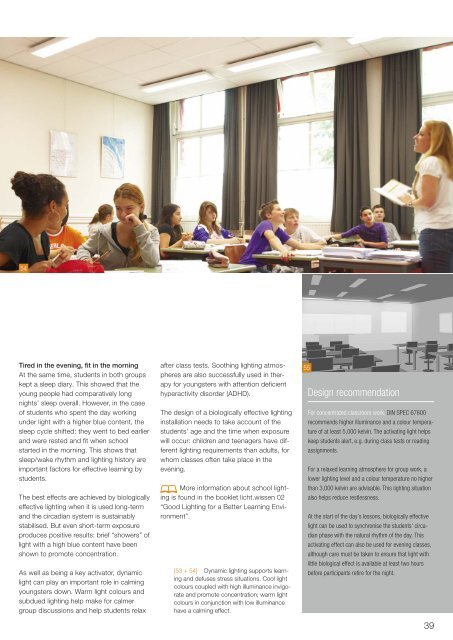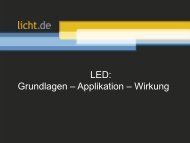licht.wissen 19 No. "Impact of Light on Human Beings"
Light synchronises our “internal clock”. Lighting that copies daylight has more than just a visual impact; it supports bodily functions 24 hours a day. Booklet 19 is intended for all those who want to delve into the topic of Impact of Light on Human Beings. The 56 pages helps to get an overview of what melanopic light can effect. Free Download at www.licht.de/en
Light synchronises our “internal clock”. Lighting that copies daylight has more than just a visual impact; it supports bodily functions 24 hours a day. Booklet 19 is intended for all those who want to delve into the topic of Impact of Light on Human Beings. The 56 pages helps to get an overview of what melanopic light can effect. Free Download at www.licht.de/en
You also want an ePaper? Increase the reach of your titles
YUMPU automatically turns print PDFs into web optimized ePapers that Google loves.
54<br />
Tired in the evening, fit in the morning<br />
At the same time, students in both groups<br />
kept a sleep diary. This showed that the<br />
young people had comparatively l<strong>on</strong>g<br />
nights’ sleep overall. However, in the case<br />
<str<strong>on</strong>g>of</str<strong>on</strong>g> students who spent the day working<br />
under light with a higher blue c<strong>on</strong>tent, the<br />
sleep cycle shifted: they went to bed earlier<br />
and were rested and fit when school<br />
started in the morning. This shows that<br />
sleep/wake rhythm and lighting history are<br />
important factors for effective learning by<br />
students.<br />
The best effects are achieved by biologically<br />
effective lighting when it is used l<strong>on</strong>g-term<br />
and the circadian system is sustainably<br />
stabilised. But even short-term exposure<br />
produces positive results: brief “showers” <str<strong>on</strong>g>of</str<strong>on</strong>g><br />
light with a high blue c<strong>on</strong>tent have been<br />
shown to promote c<strong>on</strong>centrati<strong>on</strong>.<br />
As well as being a key activator, dynamic<br />
light can play an important role in calming<br />
youngsters down. Warm light colours and<br />
subdued lighting help make for calmer<br />
group discussi<strong>on</strong>s and help students relax<br />
after class tests. Soothing lighting atmospheres<br />
are also successfully used in therapy<br />
for youngsters with attenti<strong>on</strong> deficient<br />
hyperactivity disorder (ADHD).<br />
The design <str<strong>on</strong>g>of</str<strong>on</strong>g> a biologically effective lighting<br />
installati<strong>on</strong> needs to take account <str<strong>on</strong>g>of</str<strong>on</strong>g> the<br />
students’ age and the time when exposure<br />
will occur: children and teenagers have different<br />
lighting requirements than adults, for<br />
whom classes <str<strong>on</strong>g>of</str<strong>on</strong>g>ten take place in the<br />
evening.<br />
More informati<strong>on</strong> about school lighting<br />
is found in the booklet <str<strong>on</strong>g>licht</str<strong>on</strong>g>.<str<strong>on</strong>g>wissen</str<strong>on</strong>g> 02<br />
“Good <str<strong>on</strong>g>Light</str<strong>on</strong>g>ing for a Better Learning Envir<strong>on</strong>ment”.<br />
[53 + 54] Dynamic lighting supports learning<br />
and defuses stress situati<strong>on</strong>s. Cool light<br />
colours coupled with high illuminance invigo -<br />
rate and promote c<strong>on</strong>centrati<strong>on</strong>; warm light<br />
colours in c<strong>on</strong>juncti<strong>on</strong> with low illuminance<br />
have a calming effect.<br />
55<br />
Design recommendati<strong>on</strong><br />
For c<strong>on</strong>centrated classroom work, DIN SPEC 67600<br />
recommends higher illuminance and a colour temperature<br />
<str<strong>on</strong>g>of</str<strong>on</strong>g> at least 5,000 kelvin. The activating light helps<br />
keep students alert, e.g. during class tests or reading<br />
assignments.<br />
For a relaxed learning atmosphere for group work, a<br />
lower lighting level and a colour temperature no higher<br />
than 3,000 kelvin are advisable. This lighting situati<strong>on</strong><br />
also helps reduce restlessness.<br />
At the start <str<strong>on</strong>g>of</str<strong>on</strong>g> the day’s less<strong>on</strong>s, biologically effective<br />
light can be used to synchr<strong>on</strong>ise the students’ circadian<br />
phase with the natural rhythm <str<strong>on</strong>g>of</str<strong>on</strong>g> the day. This<br />
activating effect can also be used for evening classes,<br />
although care must be taken to ensure that light with<br />
little biological effect is available at least two hours<br />
before participants retire for the night.<br />
39

















